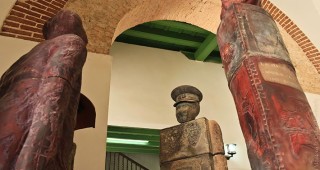This 1941 building repeats the structure of lines that emphasize verticality and includes a small two story-tower. Initially known as the Rodríguez Vázquez Building, it included two cinemas, a café-restaurant and a tower with 67 apartments. In general, it has a strong American influence, in keeping with the time of construction. The ground floor housed two large theaters: the 1,800-seater America Theatre and the Radio Cine Theatre. The building’s architects also made the projects for the El País newspaper (calle Reina, No. 158, Centro Habana), a sample of Art Deco adapted to edifices of many different sorts.

Museo Farmacia Taquechel LH  2
2
This townhouse was adapted in 1898 into a pharmacy by Francisco Taquechel. Restored and reopened in 1996, it functions as pharmacy and museum. Its collection includes 19th-century French porcelain apo …

Parque Maceo LH  2
2
Dominating the Malecón to the west, at the foot of Belascoaín (Avenida Padre Varela), is the massive bronze monument to Antonio Maceo, on top of a marble base in a plaza with a fountain. The classical …

Edificio del Seguro Médico LH  2
2
This is one of the most significant exponents of the trends in architecture in Havana of its time. According to architect Pedro Martínez Inclán, “Quintana can boast about having given Havana…two build …
 Modern23 esquina a N
Modern23 esquina a N 
Aqvarivm LH  2
2
This modest aquarium has over 90 different species of freshwater fish and aquatic plants, displayed in small tanks. Tropical fish tanks are popular in many Cuban family homes and fish can be purchased …

Memorial a los Estudiantes de Medicina LH  2
2
Inaugurated in 1890, this memorial is a shrine to eight medical students who were executed by firing squad on November 27, 1871, after being falsely accused of desecrating the tomb of Spanish journali …

Instituto de Segunda Enseñanza de La Habana LH  2
2
The Institute of Secondary Education of Havana was founded in 1863 and originally located on Calle Obispo. It was later moved to this site in 1924 as part of the construction program for the area in t …
 EclecticAdmission: n-aZulueta e/ San José y Teniente Rey, Habana Vieja
EclecticAdmission: n-aZulueta e/ San José y Teniente Rey, Habana Vieja 
Museo Yoruba de Cuba LH  2
2
Created by, and housed in the headquarters of, the Asociación Cultural Yoruba de Cuba, this museum is dedicated to santería and features sculptures representing the different Afro-Cuban orishas (saint …

Museo Armería 9 de Abril LH  2
2
The Museo Armería 9 de Abril displays a large collection of firearms and bladed weapons spanning the 18th to the 20th centuries. It occupies the former Compañía Armera de Cuba, a private gun shop that …

Museo Nacional de la Cerámica Contemporánea Cubana (Casa de Francisco Aguilera Basabe) LH  2
2
Housed within Casa de Francisco Aguilera Basabe, a two-story building built in 1728, this museum exhibits Cuban art pottery from 1950 to the present day on the top floor, while the ground floor has a …
 ColonialAdmission: FreeOpen: 9am-5pm Tues-SunMercaderes esq. a Amargura, Habana Vieja
ColonialAdmission: FreeOpen: 9am-5pm Tues-SunMercaderes esq. a Amargura, Habana Vieja 
Cementerio de Espada LH  2
2
First called Cementerio General de La Habana, the Cementerio de Espada was built after the Spanish authorities issued a Royal Edict banning burials in temples because it was considered unhygienic. The …

